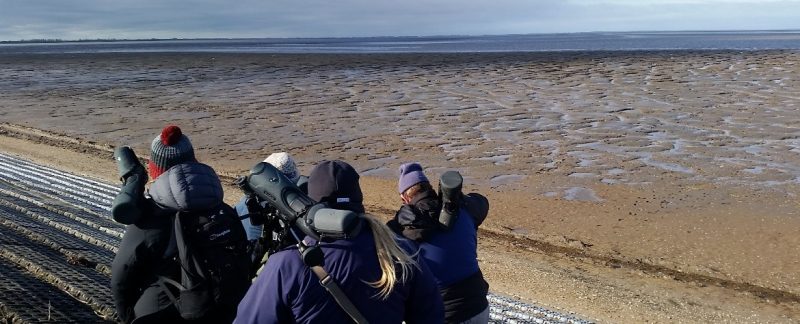Once everyone had assembled on Friday evening (and after a delicious dinner – thanks Ron!), Gary and Lou led the Wash Wader weekend and gave the briefing, making sure to ask everyone to wash their hands regularly with the growing Covid-19 situation. They explained that the aim would be to cannon net a small number of Turnstone on Heacham North North which had been seen during the recce that they had done with Cathy that morning. They’d also seen large flocks of Oystercatchers however as they have been targeted previously, it was decided that the priority would be to colour ring Turnstone. The trailer was packed the night before and the team set their alarms for 04:15.
The next morning, the team were ready to leave the base house at 04:45 as planned but lost 5–10 minutes sorting out the trailer. Once sorted, we were on our way. Arrival and setting up the site at Heacham went smoothly and preparations were finished by 06:30 (on-time!). Two large mesh nets were set on the beach which would allow people to get more experience in extracting waders. Basecamp returned to the cars and a briefing was given by Richard explaining how to lift the net should we fire. Thereafter basecamp sat on the promenade which gave them the chance to observe the movement of waders along the beach and the eventual deployment of the cannon net. As basecamp are usually sitting behind the seawall at other sites, not everyone had been able to see a cannon net in action.
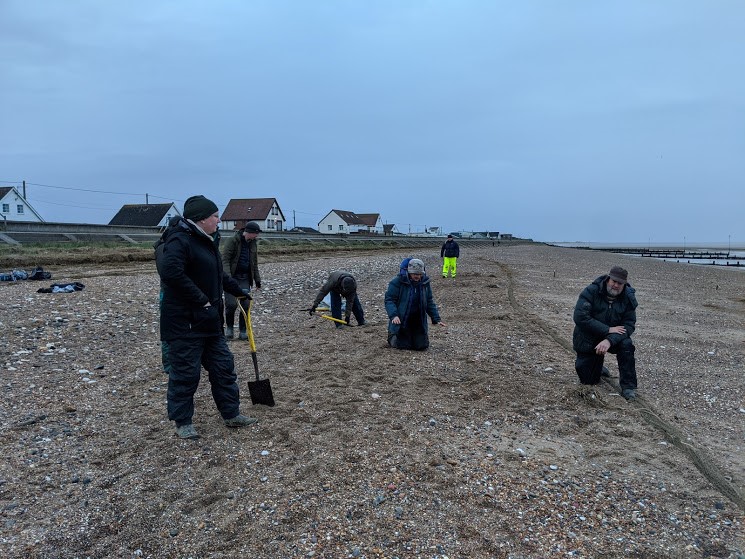
In the meantime, Lou and Gary were sat with the firing box while Nigel was sitting directly behind the nets. Long stops were Ron to the North and Ed to the South, with Richard twinkling birds from the north.
The beach was quite quiet with an Oystercatcher roost forming at the north of it. Half a dozen Ringed Plover, having territorial disputes, were observed running through the catching area. As the tide was rising, 15 Bar-tailed Godwits joined the Oystercatcher flock along with five Turnstone from the north. Richard was able to see that there was a flagged Bar-tailed Godwit and thought it might be one of his, however he was unable to read it. Nigel volunteered his scope and Cathy brought it to Richard where he identified the Bar-tailed Godwit but turned out not to be one of his flags.
Ed went to check for birds at South Heacham, which is a 30-minute walk, and due to the distance, he lost radio contact with Gary and Lou. As such Luke volunteered to walk south and relay the messages between the two. Once Luke’s radio picked up Ed, he said that he had found 15 Turnstone with half of them already marked which he would try and twinkle up to the catching area.
A Great Crested Grebe was observed swimming past, heading north and eventually came out of the water to join the Oystercatcher roost (and began preening). As the tide was approaching, some of the Oystercatchers left the roost heading to the fields and it was decided that that Nigel would shorten the jump leads. The Godwits and some Turnstone then flew and landed near but north of the nets.
Just before 09:00, six Turnstones joined them which brought the Turnstone numbers up to 10 and it was decided that Richard would twinkle them towards the catching area. Unfortunately, after being flushed they decided to fly north behind Ron.
Nigel decided that we should take what we had and Gary & Lou fired. As the jump leads had been shortened however, some of the birds were able to get out. Since it was a small catch, this allowed the less experienced members of the team to get more experience in extracting waders from large mesh nets. Gary and Lou led the ringing and processing team respectively while Ron colour ringed the Turnstones.
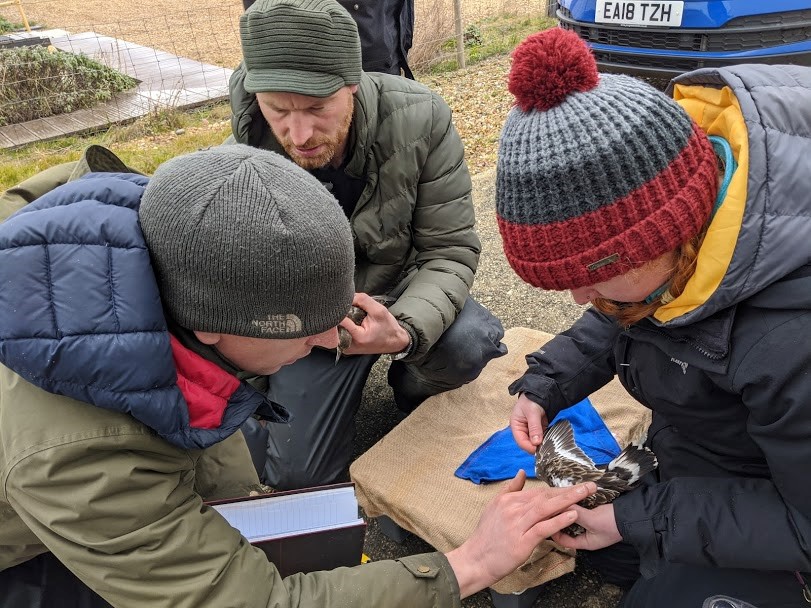
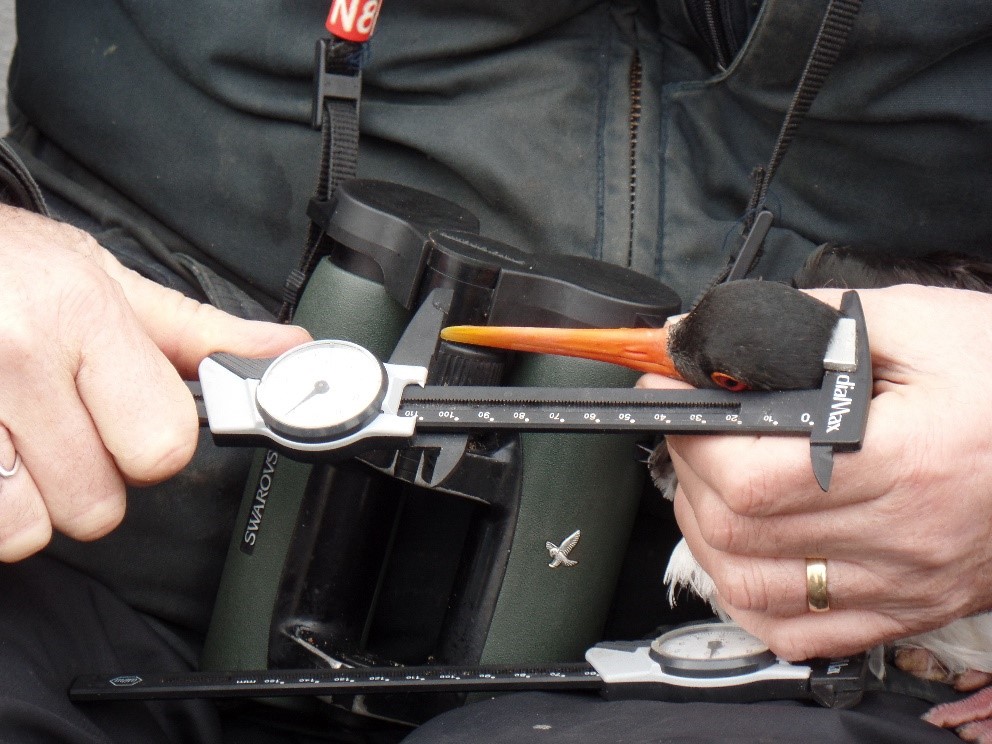
Rob P and his newest addition to the family (baby Edward) made a brief visit and then they proceeded to resight 12 Curlew flags. On top of Richard’s earlier resighting of a Bar-tailed Godwit, Ed had recorded some Turnstone colour rings and Lou had got two Curlew flags as well.
| Species | New | Retrap | Total |
| Bar-tailed Godwit | 1 | 0 | 1 |
| Oystercatcher | 1 | 0 | 1 |
| Turnstone | 2 | 3 | 5 |
| Sanderling | 2 | 0 | 2 |
| Total | 6 | 3 | 9 |
Upon return to the base house, the team had breakfast and during the briefing, Nigel tried to convince everyone that it was essential to have doughnuts with tea before we would leave to set mist nets. Once the briefing was finished several members of the team emptied the trailer and repacked it for a mist netting session at Terrington, while others did data checking.
Jacquie and Nigel had kindly provided a larger than normal sized pumpkin for dinner, which Chantal and Sara only managed to use a quarter of for 15 people! After the especially bought Berliner doughnuts were eaten with a nice cup of tea, the team went at 16:30 to set the mist nets across two pools. They set at the White Barn pools and the E pools with the latter nets set in three rows of 1, 2 and 3. Ed volunteered to stay with nets, while the rest of the team returned briefly for dinner before returning to put the tapes on at 20:00.
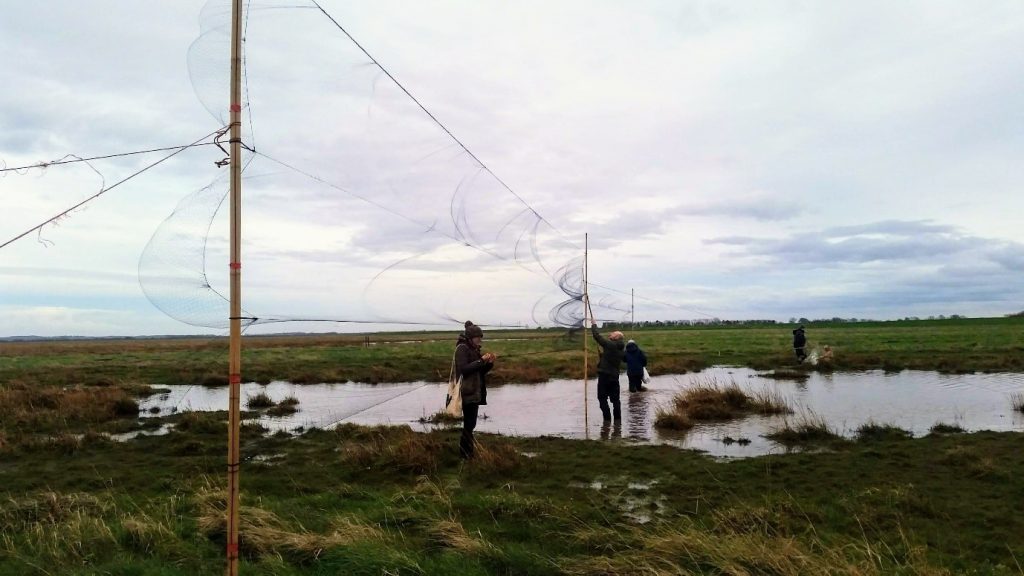
Unfortunately, there were few birds around and in conjunction with it being the windy, meant the nets only caught small numbers. Once the team had taken down the nets and returned to basecamp (at the barn), it was decided that there was no need to use the generator to ring and process the birds and instead the team kept to headtorches.
| Species | New | Retrap | Total |
| Oystercatcher | 1 | 0 | 1 |
| Redshank | 1 | 0 | 1 |
| Dunlin | 9 | 0 | 9 |
| Total | 11 | 0 | 11 |
On Sunday, the team went out to do some resightings at either Heacham North North, Freiston or Snettisham. At Frieston, the tide was well out and nothing was pushed over the sea wall but the team did see a nice selection of ducks such as Pintail and Goldeneye. There were no Turnstone resighted at Heacham North North, but most of the Curlew seen flying over the sea wall landed in the golf course nearby which allowed for some resightings. At Snettisham, the team spread out on the beach and there were several Curlew and Bar-tailed Godwit observed. They then walked to Snettisham Pits to look at the mud but as the tide had cut, not much had been covered.
Upon everyone’s return, Nigel made his famous eggy bread and then we had a morning recap. Afterwards the equipment from the previous night was taken out the trailer and put in the shed, the house was tidied and people headed home.
Resighting totals
| Species | Friday | Saturday | Sunday | Total |
| Curlew | 6 | 15 | 14 | 35 |
| Bar-tailed Godwit | 6 | 1 | 3 | 10 |
| Black-tailed Godwit | 2 | 0 | 0 | 2 |
| Knot | 3 | 0 | 0 | 3 |
| Turnstone | 8 | 8 | 0 | 16 |
| Oystercatcher | 0 | 1 | 0 | 1 |
| Dunlin | 0 | 0 | 1 | 1 |
| Avocet | 0 | 0 | 1 | 1 |
| Total | 25 | 25 | 19 | 69 |

